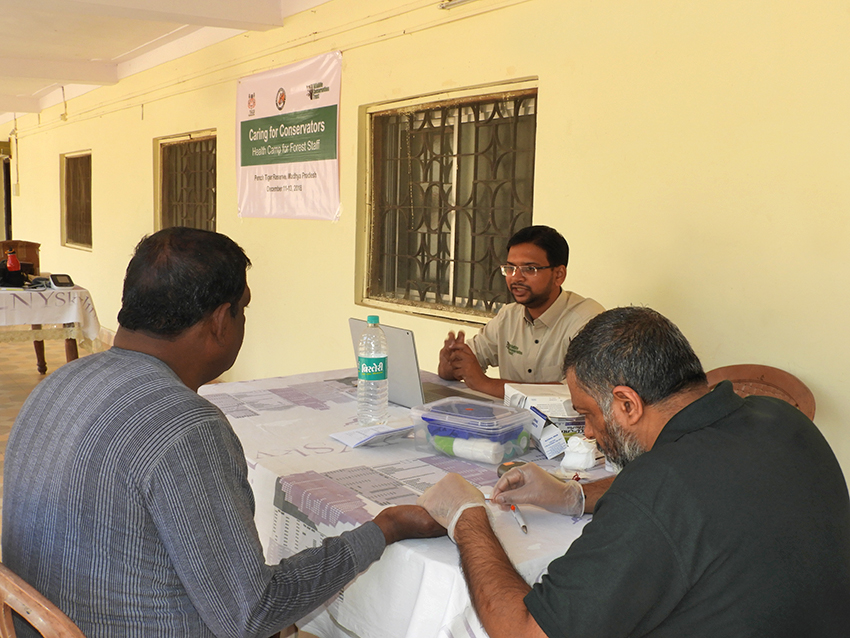Forest safaris are always a memorable affair. While the eager tourists are simply in a state of awe and excitement for almost every moment spent in the wilderness, it is the skilled and seasoned guide who walks them through the experience. The guide knows the forest, the trees, the birds, and the mammals; but is obviously unaware of what each of them would do on the day. Driving through the forest-trails, the scenery around is same for all. But it is the guide that has the vision to make sense of it all. Most miss out on things even in plain sight, some may even ignore the subtle clues; but it is the ardent guide who makes note of even a small anthill on the way, knowing well its importance in the overall scheme of things. In doing so, the guide also makes it a point to educate the tourists about the process of truly experiencing an outing in the wilderness. The tourists get to learn by experience the sense of caution and urgency through the ‘alarm-calls’ by prey animals, suggesting presence and movement of predators. Moreover, even after a ‘big nothing’ tour, the guide will ensure to impart knowledge with such enthusiasm and vigour that the tourists will forget that they did not spot the charismatic tiger. These skills take years of experience and training in navigating through the forest to be in the right place at the right time to catch a glimpse of elusive wildlife. All that effort, just for the tourist’s benefit! After all, the guide has seen it all, countless times! For most of the times the tourists get an experience of a lifetime; and while they may forget the guide, at least a part of what he or she has taught is retained.

Photo: Sanjay Thakur
The more I think about a guide’s role in a safari, more I feel tempted to draw parallels to the role of medics in WCT’s ‘Caring for Conservators’ (CFC) programme, which provides preventive healthcare to the forest staff. Just like a safari, the preventive health checks begin with the arrival of forest guards eager to know more about their own health, followed by some essential paperwork, and information on how the health-safari will be conducted. The medics playing the guide in this ‘health-safari’ start out with inquiry into the forest guard’s diet and lifestyle, and personal and familial medical history. While the forest staff’s height and weight, waist circumference, and blood-pressure are measured, and a small amount of blood through a finger prick is analysed to assess levels of blood glucose and lipids, the medics keep a steady pace of inquiry. They make sure not to miss out on even the smallest details that would offer a peek into the forest guard’s life at work. The goal is to detect any preventable health-risks that could lead to chronic non-communicable diseases (NCDs).
The medics seek to know if the forest staff feels excessive hunger and thirst, if they wake up at night for having to pass urine, if they have gained or lost weight, if they get drowsy after a big meal, if there have been any wounds that did not heal very well or took time to heal, if there were any instances of giddiness, heaviness in breathing, or if they feel out-of-breath after even a little exertion. These are things that anyone can observe but go unnoticed, or worse are ignored. Much like the guide, the medics ensure that the knowledge is shared with the forest staff so that it may be useful to them or their colleagues, or families in time of need. Apart from the medics’ assessment, the collected details are fed into a software which, based on data, sets off an ‘alarm-call’ for any risks to the forest staff’s health. The ‘heart-age’ shows aging of the individual’s heart in comparison to their own age, thus highlighting the impact of NCD risks identified during the checks. ‘Cardio-vascular diseases (CVD) risk score’ denotes the number of people who are likely to suffer from CVDs such as heart-attack, stroke, etc. in a span of ten years, if there are a hundred individuals with the same NCD risk profile as the screened individual. As the ‘health-safari guides’ educate the forest staff about the meaning of these health-indicators, the use of such scientific methods provides a personalised context for the forest staff to understand and assess how their health is being impacted.
Similar to a tourist who may find what they saw in a safari hard to believe, a forest staff at the health check begins to express his disbelief at what he has just found out about his own health.
“Arre daaktar sahaab, hum sab yaha pe itne prakritik vaatavaran mein rehte hai, saaf hava lete hai, taaza khaana khaate hai, din bhar chalte hai! Yeh jo guard hai, woh 20 kilometer tak chalta hoga din bhar mein, aur woh bhi saara jungle ka kaccha raasta! Jungle mein hi rehna, khaana-peena, sona, …aur sharab, sigaaret kuchh nahi kiye hai kabhi…maas-macchi bhi nahi khaate…” (We live so close to the nature! We breathe clean air, eat fresh food, and walk throughout the day! The forest guards walk nearly 20 kilometres in a day, that too on a difficult forest-terrain! We spend all our lives in the forest…and I have never indulged in alcohol, cigarette, etc.; neither do I eat meat…)
How could someone with such a lifestyle have raised blood pressure or high cholesterol? And what is all this talk about his heart being older to him? It was born at the same time as him after all! The forest staff, despite being in a state of disbelief, speaks the truth. He has no reason to lie, and all his friends are around to taunt him if he does.
Much like the guide scouting for tracks, the medics navigate the conversations in order to extract more information. As expected, further inquiry into forest staffs routine at work leads to a sheepish response from him, and out comes from his pocket a sachet of tobacco/supari (betel nut)/gutkha/pan-masala. He seeks support from a colleague and makes a confession.
“Ha! Bas sirf ye thoda sa chaba lete hai…ye koi din mein 3-4 baar…fir koi pyaas-bhook ka jhamela nahi rehta, karte rehte hai din bhar kaam…ya phir jungle mein akele baithe kya karein, tab kha lete hai…aur yeh toh bas jab se hosh sambhala tab se shuru hai…20-25 saal ho gaye honge samajh lijiye…ab daaktar se kya chhupaana…kyu bhai?” (Yeah; I just chew this a little….may be 3-4 times in a day…then I don’t get flustered with hunger or thirst while working throughout the day…or when I am all alone in the forest and have nothing else to do, then I consume it…and I’ve been having it since early days, as early as I can remember…maybe the last 20-25 years…no point hiding things from the doctor, right?)

The ‘guides’ look for more ‘tracks and signs’. The forest staff is unable to open his mouth very wide. A leathery patch on the inside of his cheeks is noted: as expected, an ominous sign of worse things to come – like mouth cancer, which is a serious concern for those who chew areca (betel nut) or tobacco products. While the raised blood pressure, abnormal lipids, and high risk of CVDs could all be a result of years of tobacco-use, the forest official is also at risk of developing oral-cancer. The identified health-risks and possible ways to prevent further damage are explained to him by the medics. Much like the tourists thanking the guide and their good-fortune for a wonderful wildlife sighting, the forest staff on the health-safari realises the stakes and thanks the medics, and also, his stars, for having had the checks done in time. A pledge to make necessary changes to lifestyle follows, including stopping the use of tobacco with immediate effect!
However, unlike the wildlife-sightings during forest safaris; such conversations about forest staffs’ health-risks have become a common phenomenon. Rather, much common than we’d have hoped for when we began the CFC programme for the forest staff deployed at several of India’s tiger reserves. Use of tobacco, either chewed or smoked, is one of the most prevalent NCD risk-factors identified among nearly half of the screened forest staff. However, it is not the only NCD risk-factor among them, as diet and lifestyle play a major role in raising the risk-burden. For the forest staff, meal timings are mostly irregular, and it takes planning and coordination between the staff changing shifts to make sure fresh vegetables are part of their meals while working in remote forest areas. The only proper meals in the day are at the end of it, which commonly include fried or oily foodstuff. Shortly after dinner, the forest staff hit the bed to catch some rest. Additionally, there is also use of alcohol which may include local moonshine. These diet and lifestyle practices could lead to raised lipid levels, raised blood pressure, raised blood glucose, increased waist circumference, and obesity – all of which should be under control for a physically active population-group. Having followed this routine throughout their lives, the forest staff can’t even imagine that such ‘insignificant’ things could put their lives at risk. Being at work for almost throughout the day, most of them have neither the access to useful health information nor the time and resources to practice a ‘healthy’ lifestyle.
Despite enough evidence of its impact on field-capacities of the forest staff, their health has remained one of the least discussed aspects in conservation. Among health-risks, NCDs have become the leading cause of death and disabilities across developing countries. Low and lower-middle-income countries, like India, face the major brunt of the problem owing to inequities in access to healthcare, especially for rural populations. The forest staff members are among the most marginalised occupation-groups working in remote forested settings that lack access to even basic healthcare.
While we agree that NCDs, like most health issues, require a multi-sectoral approach for their resolution, we believe that it is in interest of conservation to have a healthy workforce, capable of effective enforcement of wildlife laws. NCDs thus need to be acknowledged as a threat to conservation capacities, both at present and in future. Workplace-based preventive interventions, such as the CFC programme, have been promoted as an effective strategy for NCD prevention. Till date, the CFC programme has benefitted over 16,000 forest staff at 22 tiger reserves and seven wildlife sanctuaries in six Indian states. WCT in association with the Tulsi Foundation, UK, would certainly continue with its work highlighting the health risks to forest staff and their impact on conservation. Through our efforts, we aim to help prevent NCDs which are an unnoticed threat to the health of the forest staff, and bring about more collaborative efforts to improve the forest staffs’ access to healthcare. The more support we get, the merrier would be the experience of this ‘preventive healthcare-safari’!
Disclaimer: The author is associated with Wildlife Conservation Trust. The views and opinions expressed in the article are his own and do not necessarily reflect the views and opinions of Wildlife Conservation Trust.
Related Links
- One Health
- Reinforcing Forest Protection
- Conservation Strategy
- Save Our Tigers Campaign
- 12000 Forest Officers Trained in Wildlife Law Enforcement
- Communities
- New railway lines set to cut through 13 tiger corridors
